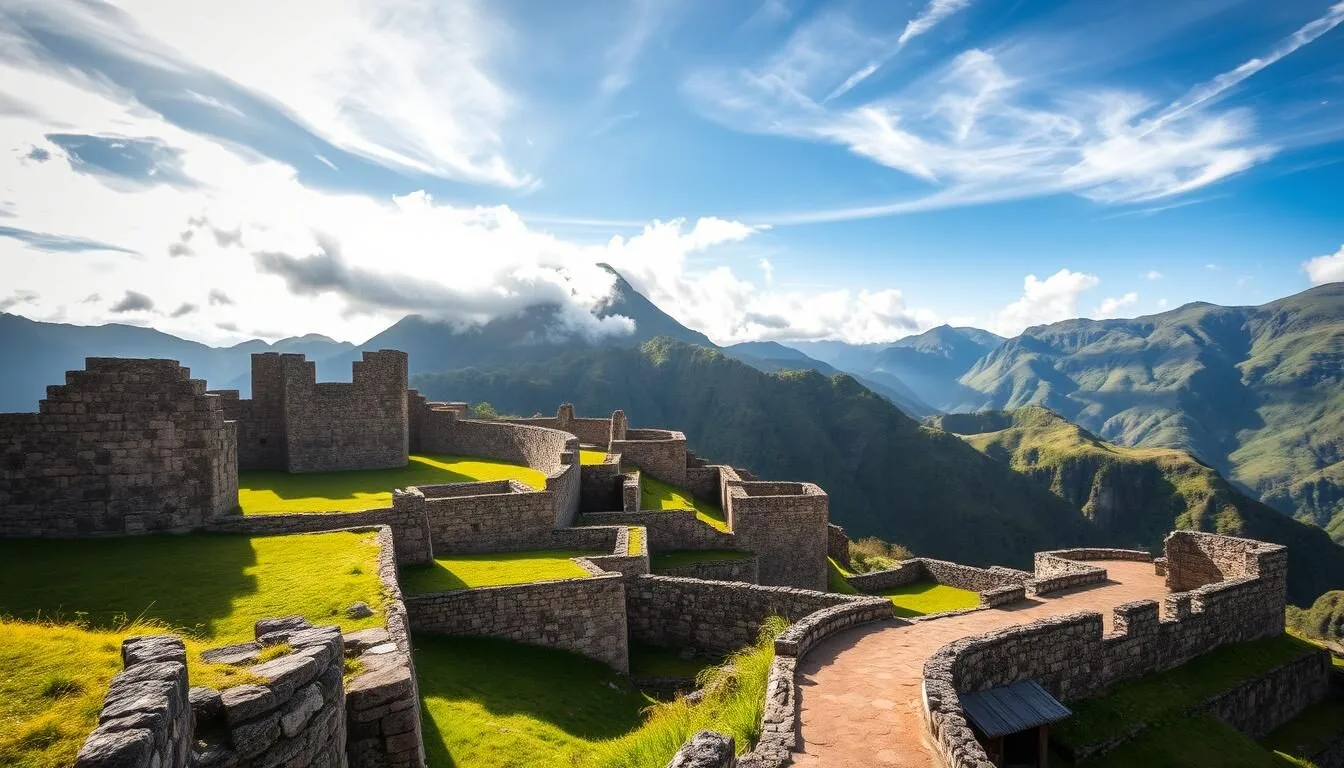✓ Accommodations✓ Flights✓ Rental Cars
You are about to embark on a journey to one of South America’s most impressive historical sites. The Kuelap fortress, often referred to as the “Machu Picchu of the North,” is a marvel that rivals its more famous counterpart in size and historical significance.
This ancient walled city, built by the Chachapoya culture at an altitude of over 3,000 meters, boasts more than 400 stone structures. As you explore this archaeological wonder, you’ll uncover the secrets of a civilization that predates Machu Picchu by several centuries.
Discover why Kuelap is becoming a sought-after destination for travelers seeking authentic cultural experiences. With its unique circular architecture and strategic mountain location, this pre-Inca fortress offers a glimpse into Peru’s rich historical tapestry.
Discovering Kuelap: Peru’s Ancient Cloud Fortress
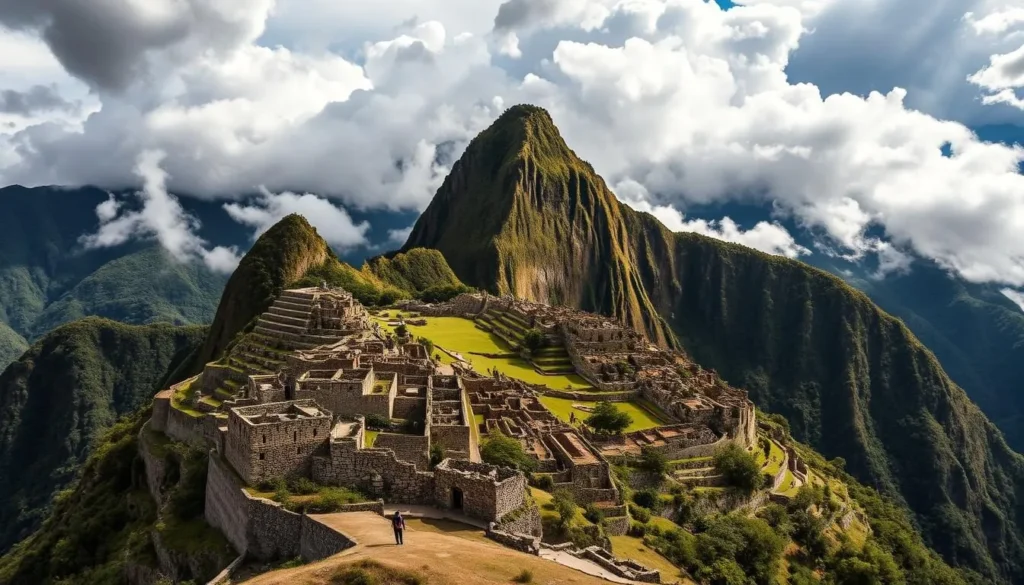
Kuelap, Peru’s magnificent cloud fortress, offers a journey into the heart of the Chachapoya culture, nestled in the rugged landscape of northern Peru. This ancient fortified city, constructed by the Chachapoya people, is a marvel of engineering and a testament to the region’s rich history.
Located in the Amazonas region of northern Peru, near the border with Ecuador, Kuelap is often compared to Machu Picchu due to its size, breathtaking location, and historical importance. At over 3,000 meters above sea level, it stands even higher than Machu Picchu, which is around 2,400 meters.
- Step into the world of the ancient Chachapoya civilization as you discover Kuelap, Peru’s magnificent cloud fortress perched high in the northern Andes mountains.
- Marvel at this engineering masterpiece built at over 3,000 meters above sea level, making it even higher than the famous Machu Picchu.
- Understand why the Amazonas region of northern Peru holds one of South America’s most impressive yet under-visited archaeological treasures.
- Learn how this massive fortified complex served as both a defensive stronghold and a thriving city for the Chachapoya people, who flourished here long before the Inca Empire.
- Appreciate the strategic positioning of Kuelap, surrounded by steep cliffs and deep canyons that provided natural protection for its inhabitants.
- Discover why archaeologists and historians consider this site to be of equal historical importance to Machu Picchu, despite receiving only a fraction of the visitors.
- Prepare to be amazed by the sheer scale of this ancient fortress, which covers an area of 218 hectares and features walls reaching up to 20 meters in height.
Kuelap is not just a historical site; it’s an experience that transports you into the world of the ancient Chachapoya civilization. As you explore this magnificent fortress, you’ll gain a deeper understanding of the people who once called it home and the significance of its location in northern Peru.
The Rich History of Kuelap
As you explore Kuelap, you’re stepping into a world of ancient history and cultural significance. This fortress, perched on a mountain ridge in northern Peru, is a testament to the ingenuity and skill of the Chachapoya people.
The Chachapoya Civilization
The Chachapoya civilization, known as the “Warriors of the Clouds,” thrived between the 8th and 16th centuries. During this time, they developed a unique culture that flourished independently in the region. Their people built extraordinary structures for religious, administrative, and defensive purposes, many of which remain intact today.
Their distinctive architectural style and cultural practices differed significantly from those of the later Inca Empire. You can still see the remnants of their remarkable achievements as you walk through the site.
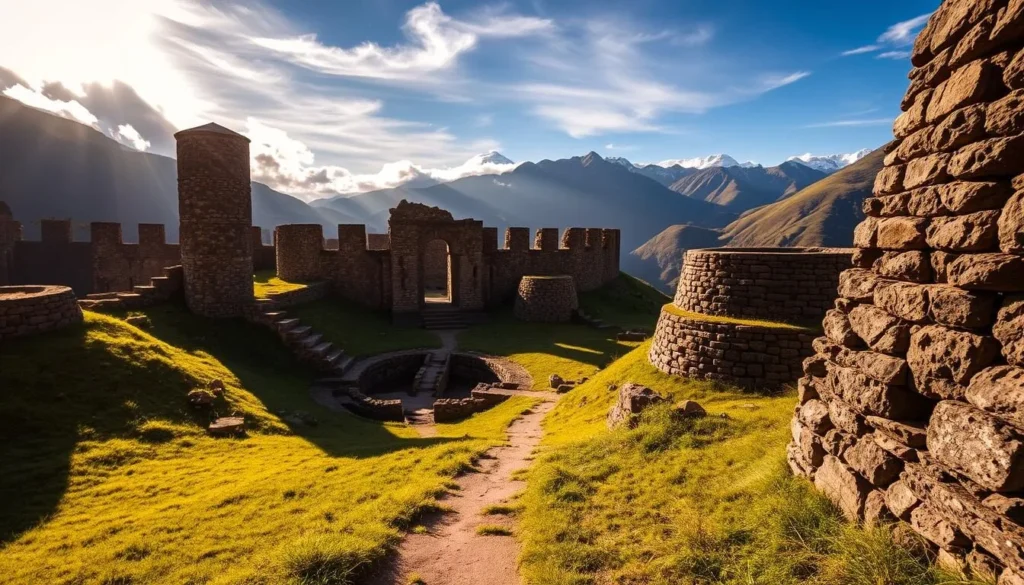
Construction and Abandonment
The construction of Kuelap began as early as the 6th century and continued for hundreds of years. The site served multiple purposes, housing up to 5,000 people at its peak. Despite its significance, Kuelap was eventually abandoned after the Spanish conquest around 1570 AD.
The reasons for its abandonment remain a mystery, leaving historians to piece together the history of this ancient fortress. The ruins stood hidden for centuries until their rediscovery in the 19th century. Ongoing research continues to reveal new insights into the culture and achievements of the Chachapoya civilization.
As you explore Kuelap, you can appreciate the advanced skills of this ancient culture and the significance of this site in the history of Peru.
How to Get to Kuelap
Reaching Kuelap is an adventure in itself, with several options to suit your travel preferences. The journey begins with getting to Chachapoyas, the main town in the Amazonas region of Peru.
Flying to Northern Peru
You can fly directly from Lima to Chachapoyas, which is the most convenient option if flights are available. This flight takes about 1 hour and 45 minutes. Alternatively, you can fly to Jaén, a journey of around 1 hour and 25 minutes, and then take a 4-hour bus ride to Chachapoyas. For the more adventurous, a bus journey from Lima to Chachapoyas is also an option, though it’s a longer trip of 22 to 24 hours through the Andes.
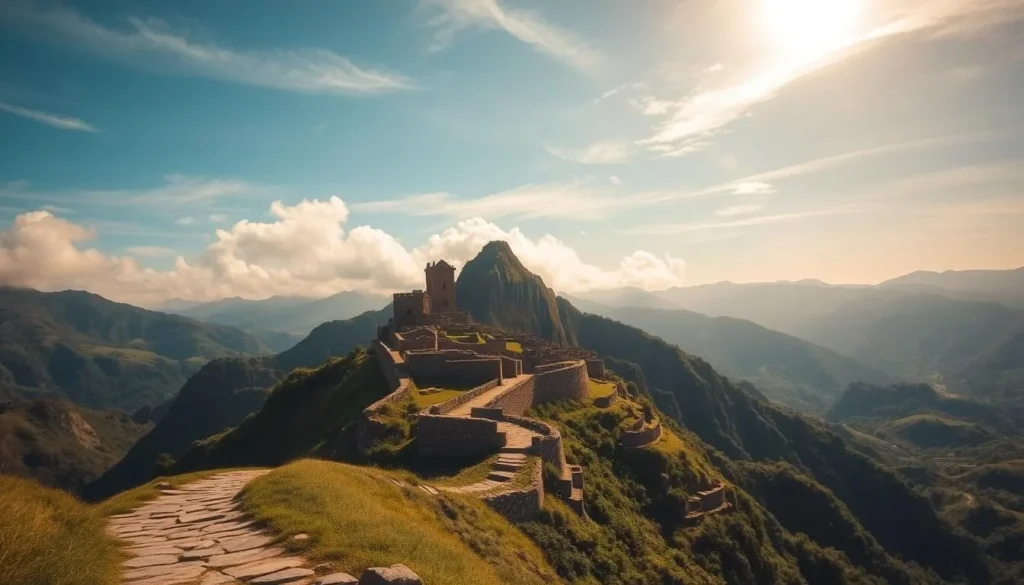
From Chachapoyas to Kuelap
Once in Chachapoyas, you’ll need to get to Nuevo Tingo, a journey of about an hour by shared taxi or colectivo. From Nuevo Tingo, a cable car takes visitors up to Kuelap. Many travelers opt for organized tours that handle all the logistics, making the journey smoother.
The Hiking Option
For those who enjoy hiking, there’s a 9-kilometer trail from Tingo Viejo to Kuelap that takes approximately 4 hours to complete. This option offers stunning views of the surrounding landscape, making it a memorable part of your adventure.
Planning your trip to Kuelap involves considering your travel preferences and physical condition to choose the best option for you. Whether you prefer a quick flight, a scenic bus ride, or an adventurous hike, the journey to Kuelap is sure to be an unforgettable experience.
The Kuelap Cable Car Experience
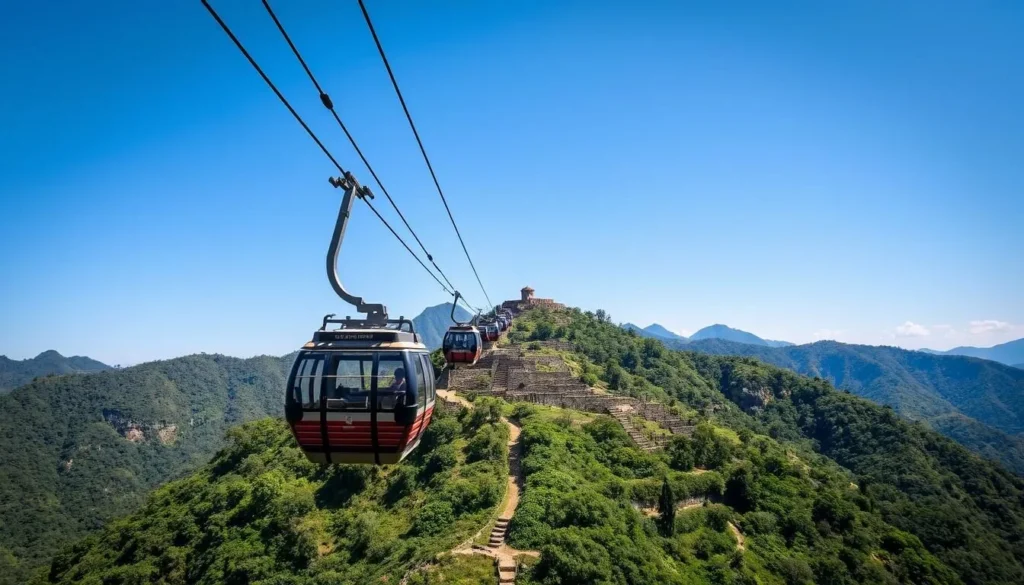
Peru’s first cable car system has revolutionized access to Kuelap, making it easier and more exciting. The cable car covers approximately 4 kilometers, providing a 20-minute aerial journey with breathtaking views of the Utcubamba Valley below.
At Nuevo Tingo, you can purchase your cable car ticket for 25.90 soles, which includes a short 10-minute bus ride to the cable car platform. The ride itself is an experience you won’t forget, as you ascend more than 1,000 meters in elevation, with the ancient fortress gradually coming into view against the stunning backdrop of the Andes mountains.
Some key highlights of the Kuelap cable car experience include:
- Enjoying a spectacular 20-minute aerial journey that spans approximately 4 kilometers up the mountainside.
- Learning about the practical aspects of the cable car experience, including ticket prices and operating hours.
- Understanding how this transportation innovation has significantly cut travel time, eliminating a 90-minute drive on winding dirt roads.
- Capturing stunning photos during your cable car journey as you take in the breathtaking views.
The Kuelap cable car is a modern addition that has made this ancient site more accessible while preserving the natural beauty of the surrounding landscape. It’s a practical way to reach the fortress, and it adds a unique element to your overall experience.
Kuelap, Peru: Best Things to Do – Top Picks
As you step into the ancient fortress of Kuelap, Peru, you’re immediately immersed in a world of history and mystery. This magnificent site is filled with impressive structures and intriguing stories, making it a must-visit destination for any traveler.
Exploring the Impressive Outer Walls
The massive outer walls of Kuelap are an engineering marvel, reaching heights of up to 20 meters. These stone fortifications surround the site, providing a secure enclosure for the inhabitants. As you walk along the walls, you can appreciate the ingenuity of the Chachapoya people who built this fortress.
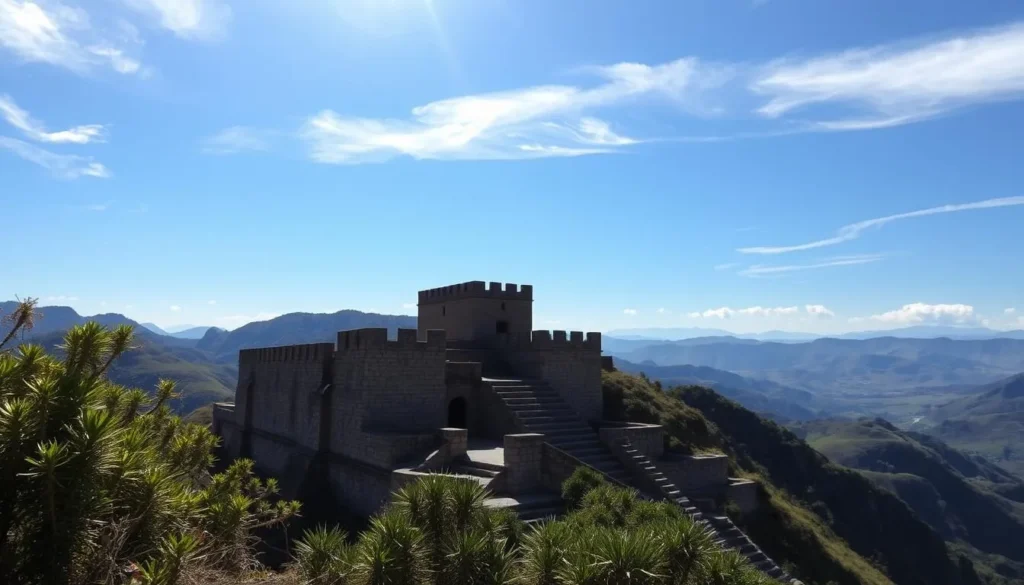
Discovering the Three Unique Entrances
Kuelap has three narrow entrances, two on the eastern side and one on the west. These entrances are designed to funnel visitors into narrow passageways, providing a significant tactical advantage to the ancient inhabitants. As you make your way through these entrances, you’ll appreciate the clever design that added an extra layer of security to the fortress.
Visiting the Main Temple and Circular Platform
The Main Temple was the most important religious structure in Kuelap, where many human remains were buried. Only the elite had access to this temple, making it a significant archaeological find. Nearby, the Circular Platform was the residence of an important elite family, offering insights into the lives of Kuelap’s ancient inhabitants.
| Attraction | Description |
|---|---|
| Main Temple | Important religious structure with human remains |
| Circular Platform | Residence of an elite family |
| Watchtower | Panoramic views of the surrounding mountains and valleys |
Wandering Among the 400+ Circular Houses
As you explore Kuelap, you’ll wander among over 400 stone circular houses that make up the majority of the site. This distinctive architectural feature sets Kuelap apart from other ancient ruins in Peru. Take your time to appreciate the intricate details of these structures and imagine life in this ancient settlement.
Climbing the Watchtower for Panoramic Views
For breathtaking views, climb to the watchtower at the northern end of the fortress. From this vantage point, you can see the surrounding mountains and valleys, taking in the natural beauty of the region. As you enjoy the view, consider the possible function of the watchtower as a ceremonial site where pebbles were thrown to call for rain.
As you conclude your tour of Kuelap, you’ll have experienced the best that this ancient fortress has to offer. With its impressive architecture, rich history, and stunning natural surroundings, Kuelap is a destination that will leave a lasting impression on all visitors.
Best Time to Visit Kuelap
Kuelap’s climate is characterized by two distinct seasons that significantly impact the visitor experience. Understanding these seasons is crucial for planning your trip.
Dry Season (April to November)
The dry season, particularly from May to September, is considered the best time to visit Kuelap. You can expect mostly sunny days and limited rainfall. Although temperatures are cooler, the high-altitude sun remains strong, making sun protection essential.
Rainy Season Considerations
The rainy season, from October to April, brings warmer temperatures and occasional mist, creating a mystical atmosphere around the ancient stones. This season is ideal for photography, with mist-shrouded ruins and the nearby Gocta Falls at their fullest, making for breathtaking views.
When planning your visit, consider avoiding Peruvian holiday weekends when domestic tourism peaks. It’s also recommended to spend a full day at the site to fully appreciate its grandeur.
| Season | Weather | Advantages |
|---|---|---|
| Dry (April to November) | Sunny, limited rain | Ideal for exploring ruins |
| Rainy (October to April) | Warmer, occasional mist | Mystical atmosphere, great for photography |
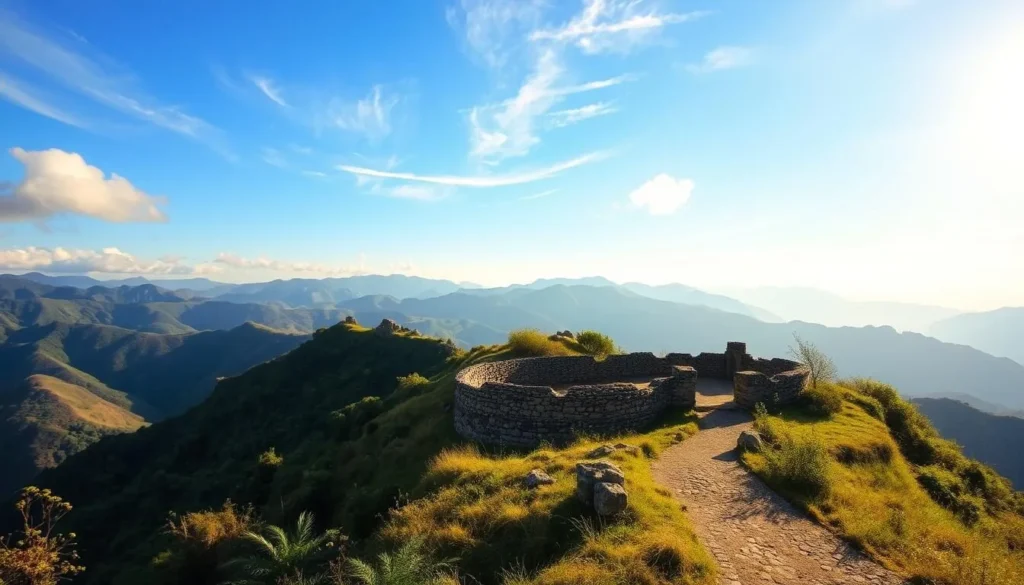
Practical Information for Visitors
To ensure a smooth and enjoyable visit to Kuelap, consider the following practical information. Understanding the basics will help you plan your day effectively and make the most of your time at this ancient cloud fortress.
Entrance Fees and Opening Hours
Kuélap is open from Tuesday to Sunday, between 9:00 AM and 2:50 PM. The entrance fees vary based on your category: foreign visitors pay 30 soles, while visitors from the Andean Community pay 20 soles. Discounts are available for students and seniors; children pay a minimal fee of 2 soles. You can purchase tickets either on-site or online through tuboleto.culture.pe, making it convenient to plan your visit in advance.
| Visitor Category | Entrance Fee (soles) |
|---|---|
| Foreign Visitors | 30 |
| Andean Community Visitors | 20 |
| Foreign Students | 15 |
| Andean Community Students | 10 |
| Seniors (60+) | 15 |
| Children | 2 |
Guided Tours vs. Independent Visits
You have the option to either join a guided tour or explore Kuelap independently. Guided tours typically cost around 80 PEN, including transportation from Chachapoyas, and offer valuable insights into the site’s history and features. On the other hand, visiting independently gives you the freedom to explore at your own pace. Consider hiring a local guide even if you choose to visit on your own, as their knowledge will significantly enhance your understanding and appreciation of Kuelap.
What to Pack for Your Visit
Preparing for your visit involves packing essential items. Don’t forget to bring your original passport, as it’s required for entry. Comfortable hiking shoes, a rain jacket or poncho, sun protection (hat, sunglasses, and sunscreen), water, and light snacks are also recommended. Given that Kuelap is approximately 9,842 feet above sea level, consider any necessary precautions for altitude sickness, such as medication or other remedies, to ensure a comfortable visit.
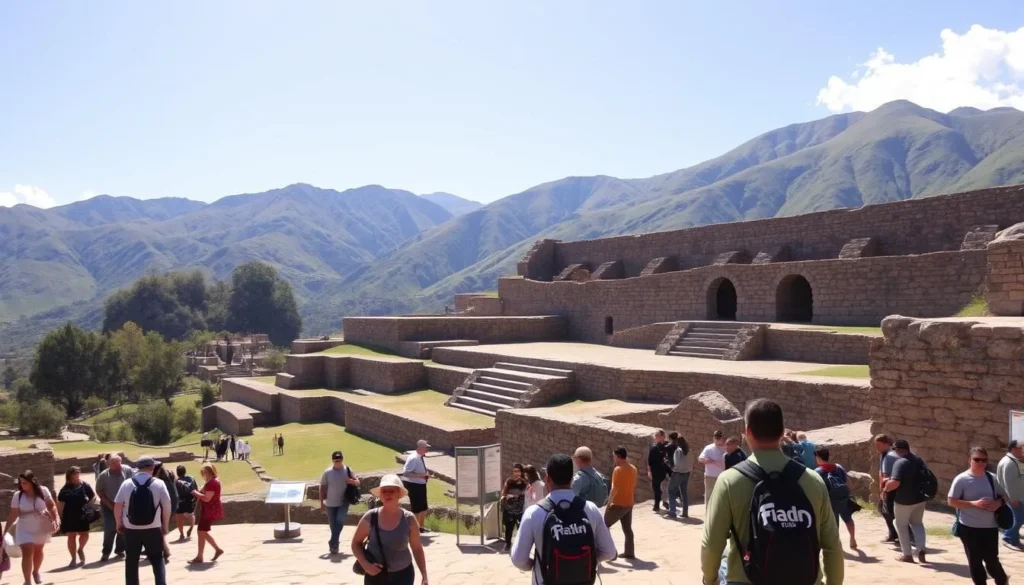
Kuelap vs. Machu Picchu: A Comparison
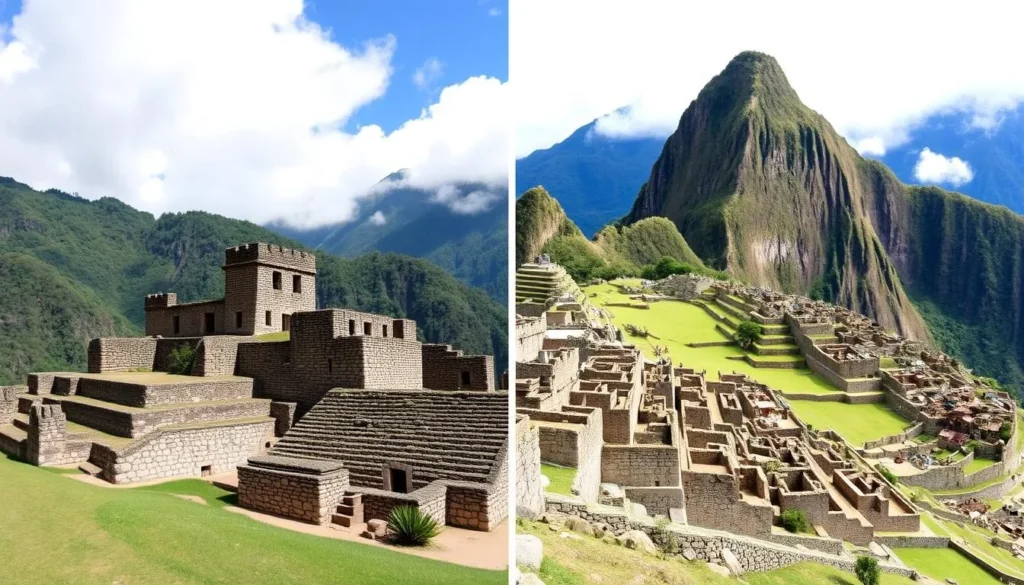
As two of Peru’s most famous archaeological sites, Kuelap and Machu Picchu have their own unique stories to tell. You might be wondering how these two sites compare, given their significance in Peruvian history.
Kuelap, often referred to as the “Machu Picchu of the North,” is between 900 and 1,100 years old, with some structures dating back up to 1,500 years. In contrast, Machu Picchu is about 600 years old. The age difference is not the only distinction; the sites were built by different civilizations – the Chachapoya for Kuelap and the Inca for Machu Picchu.
The physical characteristics of both sites are noteworthy. Kuelap is situated at a higher altitude of 9,800 feet (3,000 meters) compared to Machu Picchu’s 7,970 feet (2,430 meters). Moreover, Kuelap’s main complex is 1,968 ft (600 m) long and 394 ft (120 m) wide, whereas Machu Picchu is 1,739 ft (530 m) long and 656 ft (200 m) wide.
You will experience a significant difference in visitor numbers between the two sites. While Machu Picchu attracts about 1.5 million visitors annually, Kuelap receives around 200,000 visitors per year, making for a more peaceful experience at Kuelap.
The architectural styles of Kuelap and Machu Picchu are distinct. Kuelap features circular buildings and massive defensive walls, whereas Machu Picchu is renowned for its terraced construction and precise Inca stonework. Both sites, however, are located at the intersection of the Amazon Rainforest and the Andes Mountains, creating similar cloud forest environments.
When deciding between Kuelap and Machu Picchu, consider factors such as accessibility, historical significance, and overall visitor experience. You can appreciate the unique aspects of each site while understanding their shared importance as testaments to ancient Peruvian ingenuity.
Where to Stay Near Kuelap
The Amazonas region offers various accommodations to suit different travelers’ needs, from the city of Chachapoyas to lodges near the fortress.
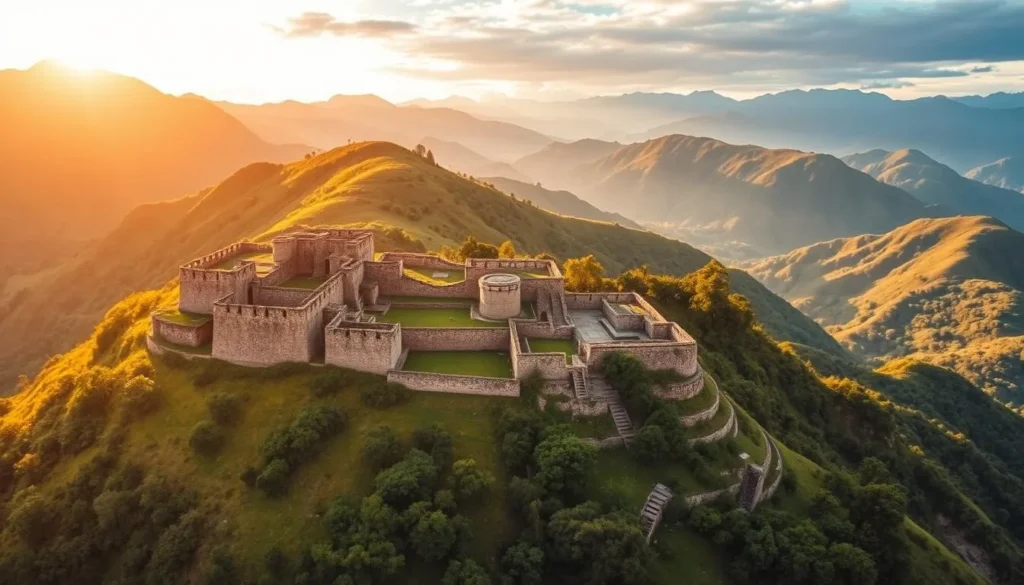
Accommodation in Chachapoyas
Chachapoyas, the capital city of the Amazonas region, is about 60km from Kuelap and offers the widest range of accommodation options. You can choose from budget hostels to comfortable 3-star hotels. Although it doesn’t offer luxury 5-star accommodations, Chachapoyas provides all the necessary amenities for a comfortable trip and serves as an excellent base for exploring the entire region.
Lodging Options Closer to the Fortress
For those who prefer to stay closer to Kuelap, there are options like Hospedaje Imperio Kuelapino, which is the closest accommodation to the fortress. It offers both dorm and private rooms with views of the mountains, ideal for travelers who want to witness the sunrise over the ruins. Another option is Gocta Andes Lodge, located between Nuevo Tingo and Magdalena, just a 5-minute drive from the cable car station. It features comfortable rooms with beautiful views and amenities like complimentary Wi-Fi. Staying in Nuevo Tingo, the town closest to the cable car station, offers basic but convenient accommodations for those who want to minimize travel time in the morning.
When planning your trip to Kuelap, consider your accommodation options carefully to make the most of your visit. Whether you choose to stay in Chachapoyas or closer to the fortress, you’ll find a place that suits your needs.
Other Must-See Attractions in the Amazonas Region
Beyond the ancient walls of Kuelap, the Amazonas region holds a treasure trove of other remarkable attractions waiting to be explored. As you travel through this captivating area, you’ll discover a rich tapestry of history, culture, and natural beauty.
Gocta Waterfall
One of the top attractions is the breathtaking Gocta Waterfall, one of the world’s tallest waterfalls at 771 meters (2,530 feet). You can plan a day trip to hike through the lush forest and catch a glimpse of the Andean cock-of-the-rock, Peru’s national bird.
Karajia Sarcophagi
Explore the unique Karajia Sarcophagi, where the Chachapoya people placed their dead in cliff-side tombs adorned with human-like figures. This fascinating site offers a glimpse into their funerary traditions.
Revash Mausoleums and Leymebamba Museum
Visit the Revash Mausoleums, another example of the Chachapoya’s distinctive cliff-side burial sites. Then, head to the Leymebamba Museum, home to 261 remarkably preserved mummies and various artifacts that tell the story of the region’s ancient inhabitants.
| Attraction | Description | Location |
|---|---|---|
| Gocta Waterfall | One of the world’s tallest waterfalls | Amazonas Region |
| Karajia Sarcophagi | Cliff-side tombs with human-like figures | Near Kuelap |
| Revash Mausoleums | Cliff-side burial sites | Amazonas Region |
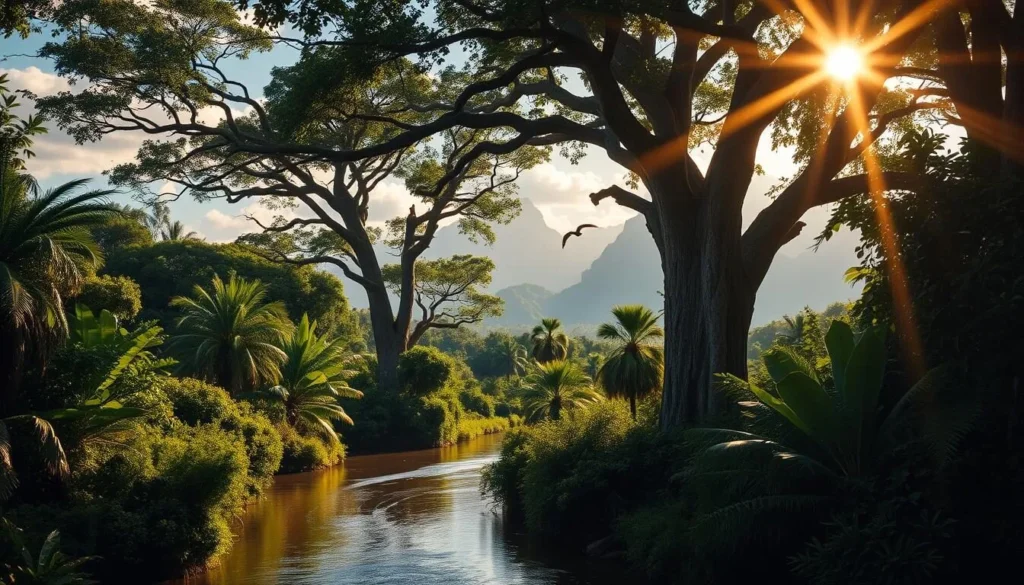
By extending your stay in the Amazonas region, you can experience the full depth of this incredible area, from its archaeological sites to its natural wonders, making your trip a truly unforgettable travel experience.
Tips for an Unforgettable Kuelap Experience
As you prepare for your journey to Kuelap, Peru, keep in mind these essential tips for an unforgettable experience. To truly make the most of your visit, it’s crucial to plan ahead and be prepared for the adventure that awaits you.
Plan Your Visit: The best time to visit Kuelap is between April and November when the weather is drier. However, if you’re up for an adventure, you can visit any time of year—just be prepared for the conditions. Spending a day in Chachapoyas before heading to Kuelap can help you adjust to the altitude, reducing the risk of altitude sickness.
Arrive Early: Getting to the fortress early in the morning allows you to experience it with fewer visitors and better lighting for photography. The dramatic interplay of light and shadow on the ancient stone walls is a sight to behold.
Transportation Options: You have several options to get to Kuelap, including the cable car from Nuevo Tingo, hiking, or hiring a car. Each option offers a unique experience, so choose the one that suits your adventure style.
Packing strategically is key. Bring layers of clothing, a rain jacket, comfortable trekking shoes, sun protection, and insect repellent. Don’t forget your camera with extra batteries to capture the magnificent views, and take time to absorb the atmosphere of this ancient city.
Lastly, carry sufficient cash in Peruvian soles, as credit card facilities are limited in this remote region. Consider hiring a knowledgeable local guide to enhance your understanding and appreciation of the site. With these tips, you’re ready to make the most of your Kuelap adventure.
—
The above is subject to change.
Check back often to TRAVEL.COM for the latest travel tips and deals.
